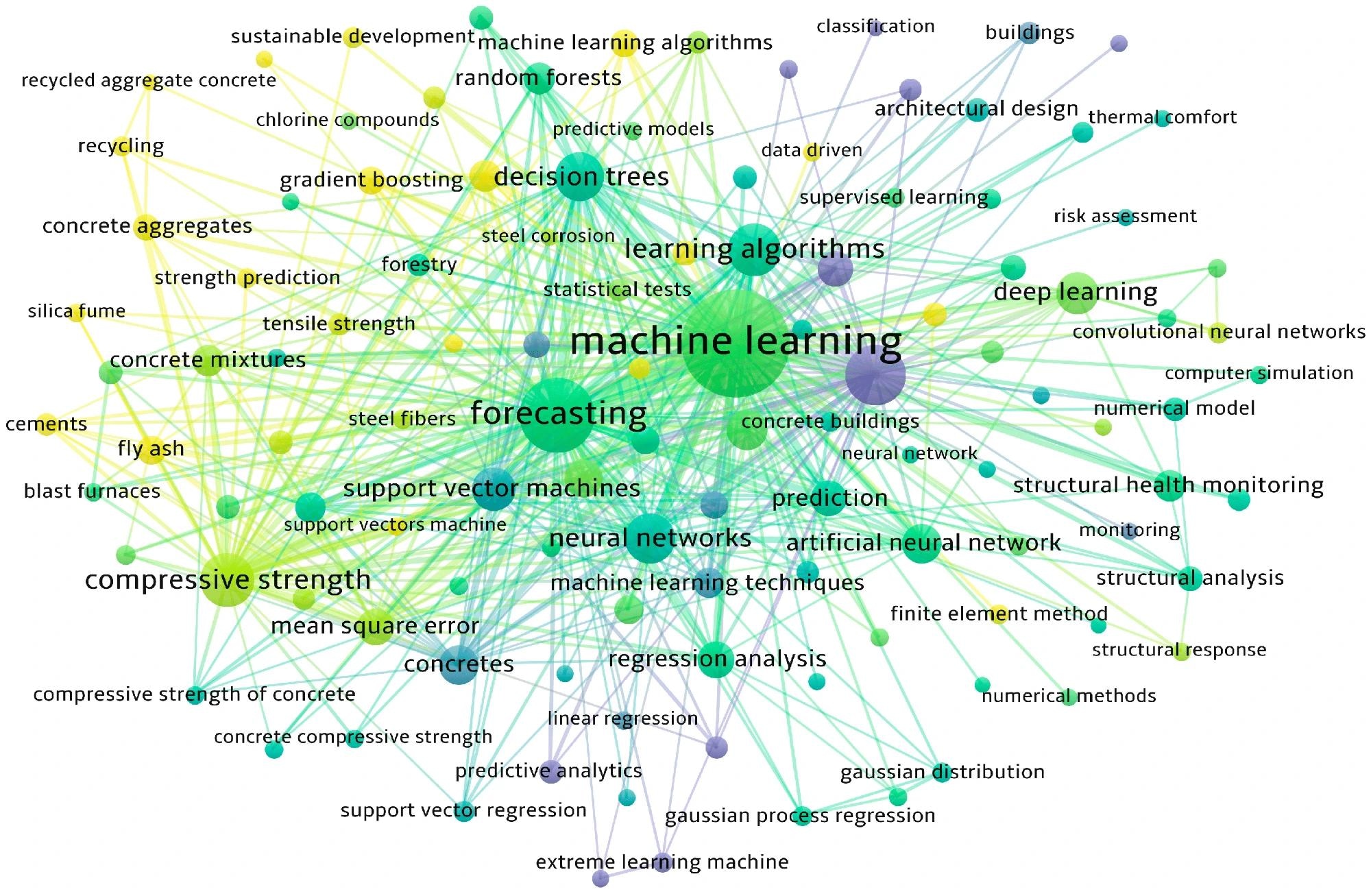In a paper published in the journal Buildings, researchers conducted a scientometric review of machine learning (ML) applications in seismic engineering, highlighting its rapid development and various uses, including predicting material performance and seismic resistance.
 Systematic map of keywords. Image Credit: https://www.mdpi.com/2075-5309/14/5/1393
Systematic map of keywords. Image Credit: https://www.mdpi.com/2075-5309/14/5/1393
They identified key sources, keywords, authors, and articles using the Scopus database. The data was visualized and analyzed using the visualization of similarities viewer (VOSviewer) to provide insights into research trends and foster collaboration in the field.
Related Work
Previous research extensively explores earthquake impacts and ongoing efforts to mitigate them, highlighting advancements in seismic engineering. However, seismic engineering needs more integration with information technology than other fields. To this end, artificial intelligence (AI) offers potential solutions, especially ML.
ML has seen significant progress since the mid-20th century, with applications in earthquake prediction, post-earthquake assessment, and pre-earthquake design. The analysis sought to reveal patterns in research, identify influential authors, and map collaborative networks, all to foster academic exchange and innovation.
Pre-earthquake ML Dynamics
The analysis explores pre-earthquake design research, focusing on integrating machine learning (ML) techniques. It reveals a substantial increase in publications, led by engineering, materials science, and computer science domains. ML is pivotal in predicting material properties and evaluating structural capabilities, with over 2500 publications by 2023 indicating a significant transition towards more efficient construction practices.
Key trends include prominent publication sources, collaborative networks, and prevalent ML algorithms such as neural networks and decision trees. It signifies a shift towards sophisticated predictive models, enhancing pre-earthquake design methodologies for more robust structural assessments.
Seismic Risk Mitigation
Examining post-earthquake assessment literature reveals a predominant focus on engineering, earth and planetary sciences, and materials science. While ML techniques are extensively used in pre-earthquake scenarios, their application in post-earthquake damage assessment remains limited. This disparity highlights a significant research gap in leveraging ML to enhance assessment procedures following seismic events.
Post-earthquake damage assessment encounters challenges due to the severity and intricacy of observed damage phenomena. Insufficient databases tailored for training ML models constrain research progress in this field. Although numerical simulations exist, their reliability is questioned, prompting scholars to explore alternative methods, such as directly establishing numerical models from damaged states.
Geographically, the United States and China have emerged as leading contributors to post-earthquake assessment research, with notable collaborative efforts among various countries. Despite differing publication counts, Canada stands out for accumulating high citation counts, indicating the impact of its research output despite its smaller volume.
Regarding publication sources, Engineering Structures, Earthquake Spectra, and Structures are identified as key journals. Earthquake Spectra receives the highest number of citations, highlighting its influence within the field. These journals are crucial platforms for disseminating research findings and facilitating scholarly discourse.
Keyword analysis reveals common themes such as ML, detection, earthquake damage, and learning systems. ML is predominantly employed for damage detection in reinforced concrete structures, primarily utilizing deep learning algorithms. This emphasis underscores the potential of ML in automating and enhancing damage assessment processes.
Several authors have made significant contributions to post-earthquake assessment research, emphasizing the persistent challenge of obtaining high-quality datasets for damage identification. Studies often focus on supervised ML algorithms for residual performance assessment, utilizing training data from actual seismic events or simulations.
ML holds significant promise in various applications within earthquake engineering, extending beyond damage assessment. These applications include post-earthquake debris management and the formulation of strengthening strategies for damaged structures.
Future research endeavors might involve crafting comprehensive management plans for debris recovery and utilizing ML to determine suitable strengthening schemes. This advancement would propel the field beyond mere prediction and toward proactive intervention and mitigation strategies.
The post-earthquake assessment literature emphasizes the field's interdisciplinary nature and its predominant focus on specific scientific disciplines. Collaboration among researchers from diverse backgrounds, such as engineering, earth and planetary sciences, and materials science, is essential for advancing methodologies in assessing post-earthquake damage. This collaborative approach enables the integration of diverse perspectives and expertise, facilitating the development of holistic solutions to mitigate the impact of seismic events on infrastructure and communities.
Further research efforts should explore novel ML algorithms tailored specifically for post-earthquake assessment and address challenges such as insufficient databases through initiatives promoting data standardization and open-access research. By leveraging the collective expertise of researchers worldwide and advancing ML technology, significant strides can be made toward resilient and sustainable infrastructure in earthquake-prone regions.
Conclusion
To sum up, the study conducted a thorough scientometric evaluation of ML applications in earthquake engineering, analyzing 3189 papers from Scopus. Seismic design emerged as the most researched area, followed by earthquake prediction and post-earthquake assessment. China and the United States were leading contributors, with distinct publishers dominating each research field.
ML's application in pre-earthquake design primarily focused on material performance prediction, while earthquake prediction research emphasized region-specific forecasting. Post-earthquake assessment centered on damage identification through deep learning algorithms. Insights from highly cited papers highlight current trends and future directions, including the need for quality databases to refine ML models for more effective damage assessment and residual performance evaluation.